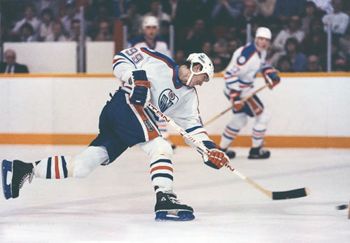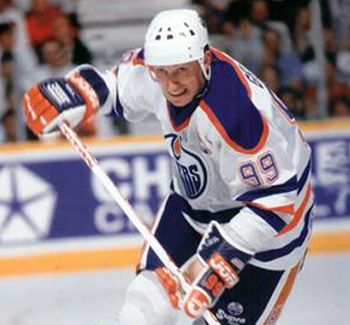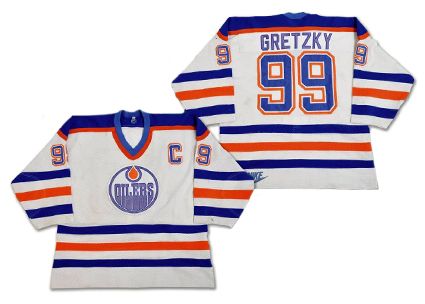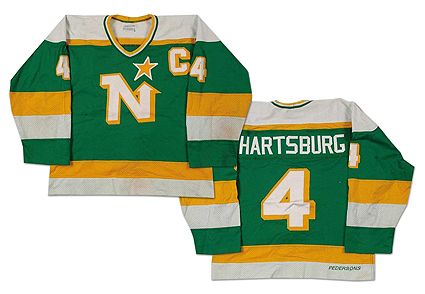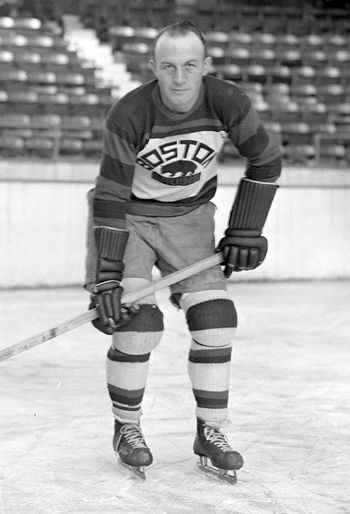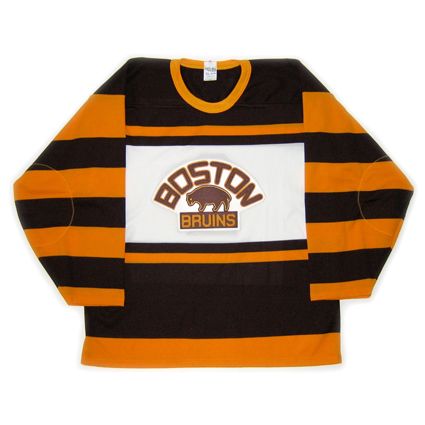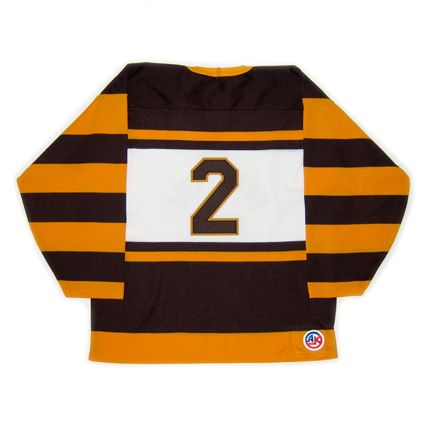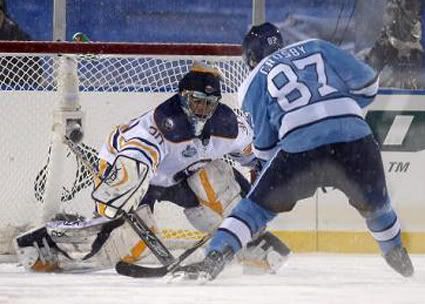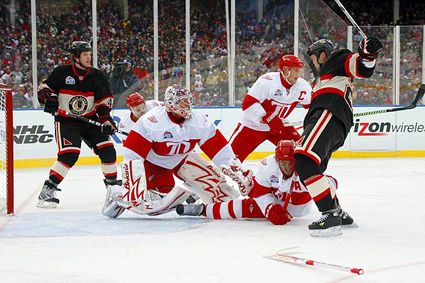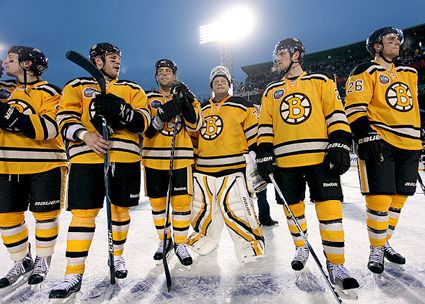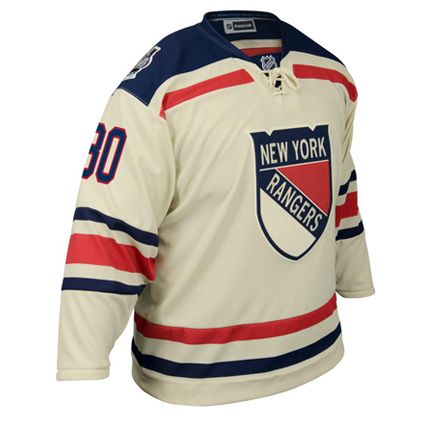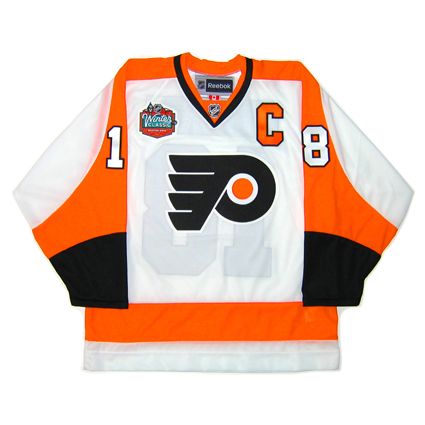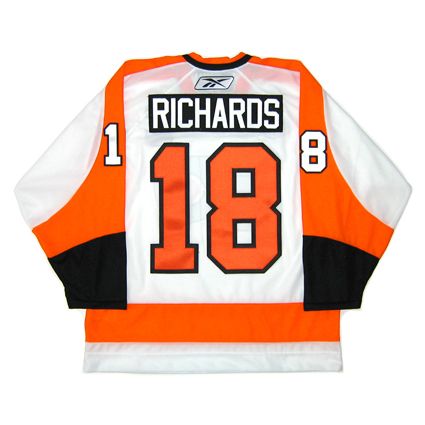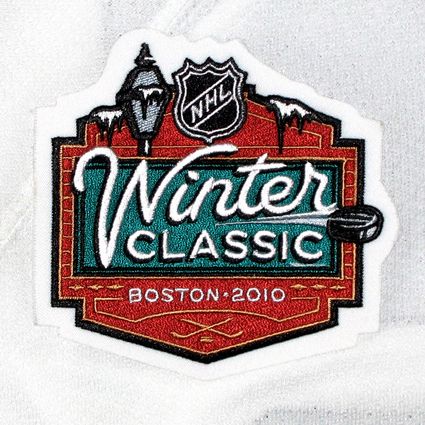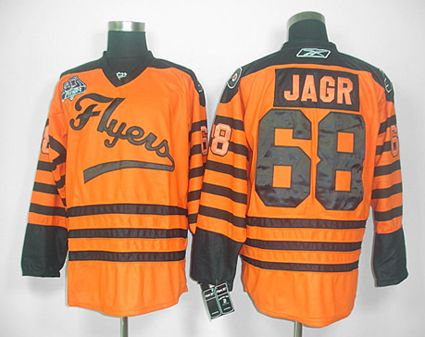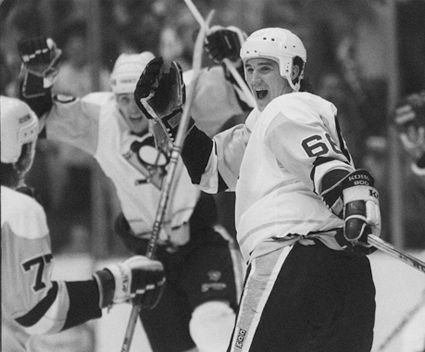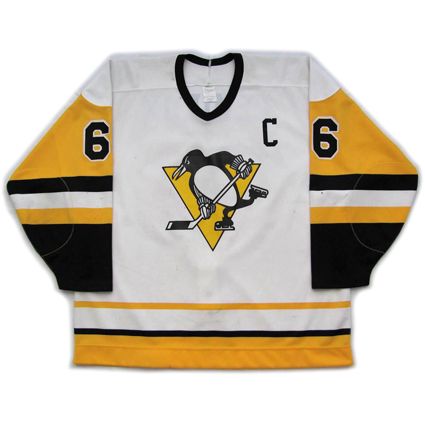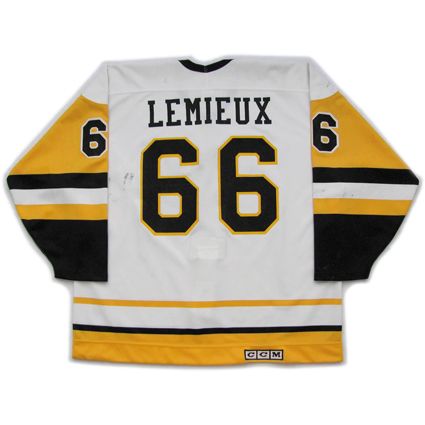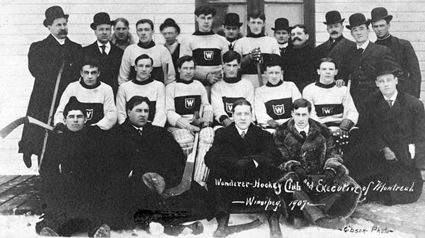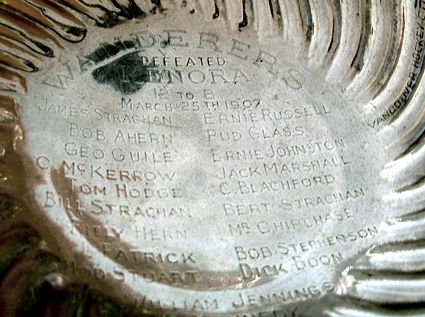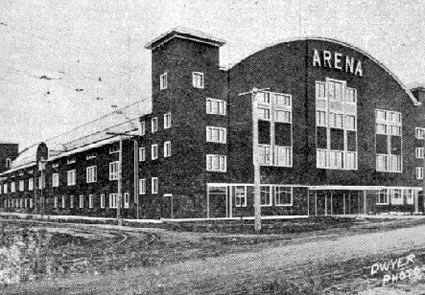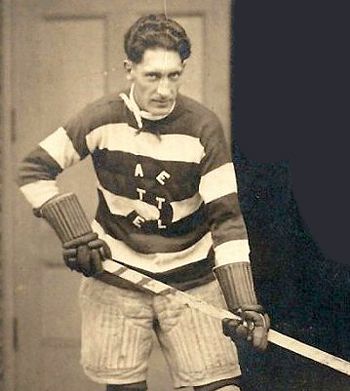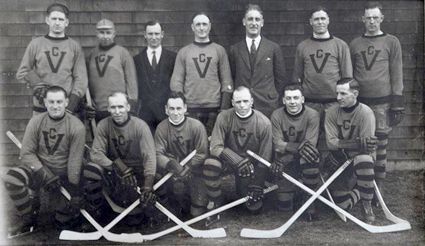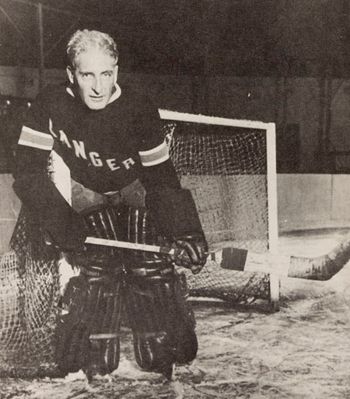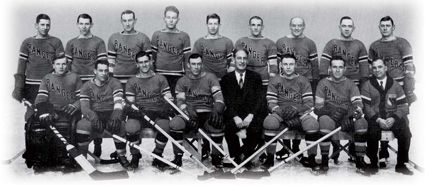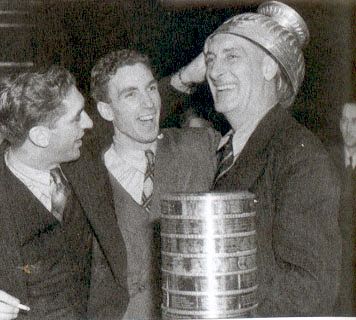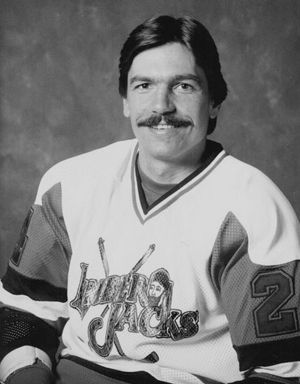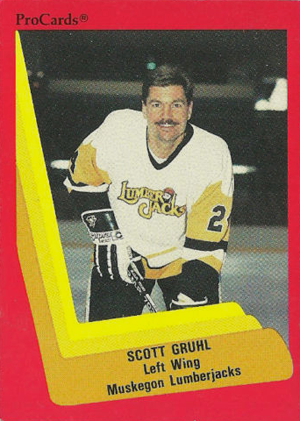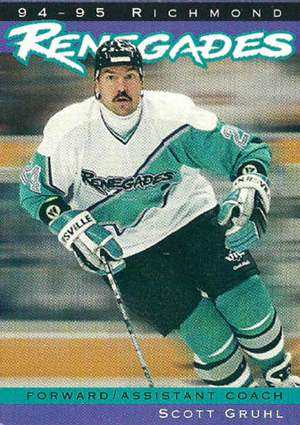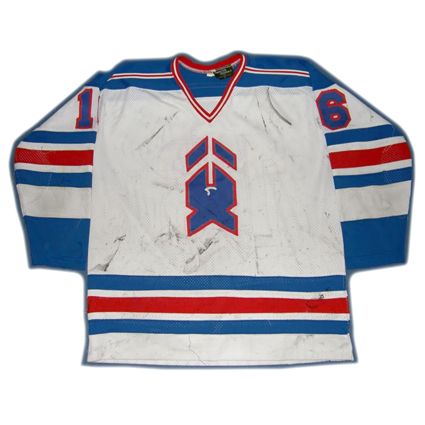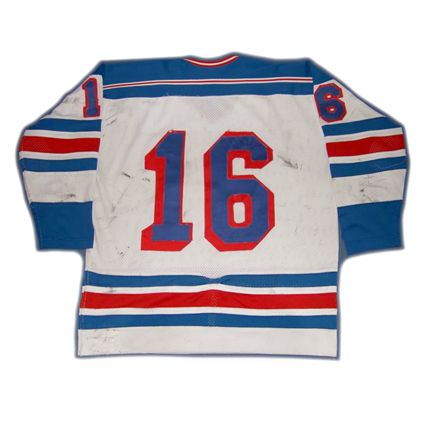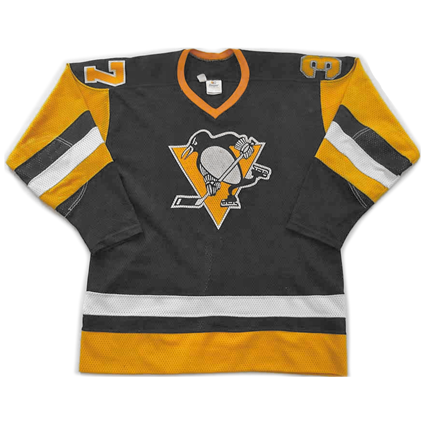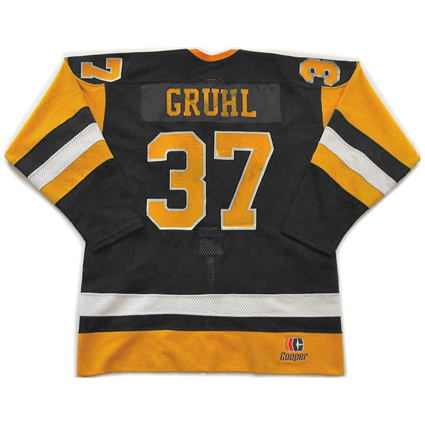Wednesday, January 4, 2012
1983-84 Edmonton Oilers Wayne Gretzky Jersey
17,498 fans filed into the Northlands Coliseum on this date in 1984 as the Edmonton Oilers were set to host the Minnesota North Stars. Grant Fuhr got the start for the Oilers, opposed by Minnesota's Don Beaupre.
At 2:07 into the game, Glenn Anderson got the scoring started with his 25th goal of the season on an assist from Mark Messier, with the goal coming at even strength. Wayne Gretzky extended the Oilers lead to 2-0 at 7:41 with his even strength goal from Charlie Huddy. It was Gretzky's 44th goal of the season, coming just two seconds after a North Stars penalty had expired.
With Dave Hunter in the penalty box for the Oilers, Minnesota got on the board when Dennis Maruk got his 10th of the season from Neal Broten and Dino Ciccarelli at 9:11.
With the feisty Gordie Roberts off for Minnesota, Edmonton restored their two goal lead when Jari Kurri scored a power play goal from Gretzky and Huddy at 15:20. Gretzky's assist extended his NHL record to 17 consecutive games with an assist, his 38th assist during the streak.
Two and a half minutes later, the North Stars struck back when Ciccarelli scored his 23rd goal from Maruk and Brad Maxwell at even strength at 17:55, still in the first period.
25 seconds later, Kurri would score his second of the period from Gretzky at even strength matched by Gretzky's second of the game 38 seconds later to make the score after just one period 5-2 in favor of the Oilers.
When the teams returned to the ice for the second period, Gilles Meloche had replaced Beaupre in the North Stars goal. Minnesota came out flying, determined to get back into the game, and in the blink of an eye, Ciccarelli has his second goal of the night from Maruk and Mark Napier at just 25 seconds. The North Stars then cut the Oilers lead to 5-4 when defenseman Maxwell netted his 12th of the season on a power play with Anderson in the box for the Oilers at 1:22.
Kurri completed his 7th career hat trick with his 38th of the year from Gretzky at 3:54, stemming the tide of the North Stars comeback - at least temporarily, as Steve Payne's 11th of the season from Broten and Willi Plett just 40 seconds later kept Minnesota within one at 6-5.
Just over three minutes later, Edmonton converted on the power play with Coffey's 20th from Gretzky and Messier at 7:31 with Brian Lawton off for Minnesota. The scoring binge subsided temporarily until the plucky North Stars got their fourth of the period from Brian Bellows, his 21st of the season at 11:27 from Napier and George Ferguson.
Taking a break from the scoring, Ken Linseman of Edmonton fought Napier at 11:50, followed by Randy Gregg's fight with Bellows less than a minute later at 12:30. Bellows received an extra minor, which put Edmonton on the power play, which they converted 16 seconds later as Gretzky completed his hat trick with his 46th goal from Anderson and Messier. The hat trick was the 24th of Gretzky's career.
Swede Willy Lindstrom joined the offensive fireworks at 14:59 from Messier and Kevin Lowe at 14:59 and Gretzky scored his 47th goal of the season, his fourth goal of the night and eighth point of the game with his goal from Messier and Kurri even strength at 17:23. Messier's fourth assist was his fifth of the game and he set an Oilers record with four coming in the span of the last 9:52.
The second period ended with the Oilers leading 10-6, thanks to their three consecutive goals to in the latter half of the period which gave them their largest lead of the night.
Despite giving up six goals, Fuhr stayed in the Oilers net for the third period thanks to the healthy Oilers lead, while the North Stars elected to stay with Meloche, as Beaupre likely wanted nothing more of the Oilers on this night.
Minnesota still had some fight left in them, as they struck back at 2:20 of the third with Keith Acton's 11th from Maxwell and Roberts, followed by Craig Hartsburg's 7th from Plett on the power play at 3:35 with Anderson back in the box.
Coffey got one back for the Oilers from Messier and Anderson at 7:10. It was Messier's sixth assist of the game. It would take over eight minutes for the next goal to arrive, the longest gap in scoring for the entire game. Gregg's 10th of the season came at 15:22 from Kevin McCelland and Pat Hughes to make the score 12-8 and send the media scrambling for their record books, as the goal was the 20th of the game, the most in the NHL since a a 21 goal game between the Toronto St. Patricks and Montreal Canadiens back on January 10, 1920 won by Montreal 14-7 nearly 64 years earlier.
With just over four and half minutes remaining, fans were hoping to witness history, but the record-tying goal never arrived, as the final stood at 12-8 despite a Minnesota power play at 17:01.
Of note, both teams had identical 12 shots on goal for each and every period, giving them 36 each for the game. Fuhr got credit for the win after making 28 saves on 36 shots, while Meloche took the loss after making 17 saves on 24 shots, while Beaupre made 7 saves on 12 shots.
This would prove to be the greatest night of Gretzky's career, with 8 points from 4 goals and 4 assists. He had one previous 8 point night earlier the same season back on November 19, 1983, which came on 3 goals and 5 assists.
Today's featured jersey is a 1983-84 Edmonton Oilers Wayne Gretzky jersey. The Oilers would go on to win the Stanley Cup at the conclusion of the season, and interestingly, each of the four times the Oilers would win the cup with Gretzky as captain, it would be at home in their white jerseys.
When Edmonton first entered the NHL in 1979 following the demise of the WHA, they changed the colors of crest of their jerseys but, aside from minor detail changes to fonts for names and numbers and some tweaking of shades of color, kept the same style for 17 seasons, which included their Stanley Cup dynasty of the 1980's.
Bonus jersey: Today's bonus jersey is a 1983-84 Minnesota North Stars Craig Hartsburg jersey. With the North Stars being 40% responsible for the 20 goals scored in their game with Edmonton on this date in 1984, it only seems fair to include them in today's entry.
This jersey was first worn in 1978, but this was the only season the Pedersons brand appeared on the rear hem of the North Stars jerseys, being replaced by a different local customizer the following season.
Oddly, in 1981-82, the North Stars added black to their home white jerseys in the form of a third black stripe to the waist, black cuffs on the sleeves and black outlines on their main crest and number in an effort to look tougher, but surprisingly chose to leave the green road jerseys as is, not adding the black to them until 1988, sticking with today's featured style some seven additional seasons.
Today's video selection are highlights from the offensive explosion which resulted in the most goals scored in over 60 years in the NHL.
Tuesday, January 3, 2012
1928-29 Boston Bruins Eddie Shore Jersey
From the Sports Illustrated Vault, the story "A Rough Time on the Road" by the great Stan Fischler originally published back on February 10th, 1964.
On January 2, 1929, the Boston Bruins boarded a night train to Montreal for a National Hockey League game there the following evening against the Montreal Maroons. As the train was pulling out of North Station, Art Ross, the Bruins' manager, walked through the Pullman sleeping car, counting the players. When Ross reached the last berth, he realized that one of them, Eddie Shore, was missing.
Eddie Shore
"Ross didn't know it," Shore said recently, "but I was then running down the platform trying to jump on the last car of the train. I didn't make it. I just missed the train because my taxi got tied up in a traffic accident coming across town."
Shore was determined to get to Montreal in time for the game. The Bruins were already shorthanded because of injuries, and Shore was well aware that Ross levied a $500 fine on any player who missed a road trip. Shore checked the train schedule and found that the next express to Montreal in the morning would not reach there until after the game had started. He learned that all the airline planes were grounded because of stormy weather. He was about to rent an automobile when a wealthy Boston friend offered to lend him a limousine with a chauffeur.
At 11:30 that night Shore and the chauffeur started the 350 mile drive over iced and snow-blocked New England mountain roads. It was sleeting, and in those days there were no paved express highways, no sanding trucks and no road patrols. The chauffeur drove very slowly through the storm. "I was not happy with the way he was driving," Shore said, "and I told him so. He apologized and said he didn't have chains and didn't like driving in the winter. The poor fellow urged me to turn back to Boston."
At that point the car skidded to the lip of a ditch. Shore took over at the wheel and drove to an all-night service station where he had tire chains put on. By then the sleet storm had thickened into a blizzard. Snow caked either side of the lone windshield wiper, and within minutes the wiper blade froze solid to the glass. "I couldn't see out of the window," says Shore, "so I removed the top half of the windshield."
His face was exposed to the blasts of the icy wind and snow but he managed to see the road. At about 5 A.M., in the mountains of New Hampshire, "We began losing traction. The tire chains had worn out."
Slowly, Shore eased the car around a bend in the road where he could see the lights of a construction camp flickering. He awakened a gas station attendant there, installed a new set of chains and weaved on. "We skidded off the road four times," he says, "but each time we managed to get the car back on the highway again."
The second pair of chains fell off at three the next afternoon. This time Shore stopped the car and ordered the chauffeur to take over the wheel. "I felt that a short nap would put me in good shape," he says. "All I asked of the driver was that he go at least twelve miles an hour and stay in the middle of the road."
But the moment Shore dozed off, the chauffeur lost control of the big car and it crashed into a deep ditch. Neither Shore nor the chauffeur nor the car suffered any damage so Shore hiked a mile to a farmhouse for help. "I paid $8 for a team of horses," says Shore, "harnessed the horses and pulled the car out of the ditch. We weren't too far from Montreal and I thought we'd make it in time if I could keep the car on the road."
He did and at 5:30 P.M. Shore drove up to the Windsor Hotel, the Bruins headquarters. He staggered into the lobby and nearly collapsed. "He was in no condition for hockey," says Ross. "His eyes were bloodshot, his face frostbitten and windburned, his fingers bent and set like claws after gripping the steering wheel so long. And he couldn't walk straight. I figured his legs were almost paralyzed from hitting the break and clutch."
Montreal's Windsor Hotel
Nevertheless, Shore ate a steak dinner, his first real meal in twenty-four hours, and refused the coach's orders to go to sleep. "I was tired all right," Shore says, "but I thought a twenty or thirty minute nap would be enough, then I'd be set to play."
An hour later Dit Clapper and Cooney Weiland of the Bruins entered Shore's room and shook him gently. Nothing happened. The rolled him over the bed and onto the floor. Still nothing happened. Weiland filled several glasses with water and poured them over Shore's face. This time he woke up and immediately insisted on playing.
Ross didn't want him to play. "I knew how durable he was," the coach says, "but there's a limit to human endurance. I finally decided to let him get on the ice, but at the first sign of weakness or sleepwalking I'd send him to the dressing room. I had to worry about him being groggy. What if he got hit hard and wound up badly hurt?"
The game was rough and fast. The powerful Maroons penetrated Boston's defense often, but Shore always helped repulse them. He smashed Hooley Smith to the ice with a vicious body check and drew the game's first penalty. Ross considered benching him at this point, but changed his mind. When the penalty had elapsed, Shore jumped on the ice and appeared stronger than ever. Shortly before the halfway point in the second period he skated behind his net to retrieve the puck. He faked one Montreal player, picked up speed at center ice and swerved to the left when he reached the Maroons' blue line. He sped around the last defenseman and shot. "I would say I was about fifteen feet out to the left," he says. "I can remember exactly how my shot went. It was low, about six inches off the ice, and went hard into the right corner of the net." The time of the goal was 8:20 of the second period. The Bruins led 1-0.
Shore still showed no signs of his ordeal during the third period (he had another two-minute penalty), and almost twenty-four hours after he chased the train down the North Station platform in Boston the final buzzer sounded. Apart from the two penalties, Shore had played the entire game without relief and, what's more, had scored the only goal of the game. Coach Ross never fined him for missing the train.
Shore would have an eventful 1928-29 season, as in addition to his heroic overnight drive through a raging blizzard, the Bruins would go on to win the first Stanley Cup of Shore's career after the Bruins won the American Division with a 26-13-5 record and go on to sweep the Montreal Canadiens 3 games to none before defeating the New York Rangers 2 games to none in what was oddly just a best-of-three final following the best-of-five semifinal!
The Stanley Cup Champion 1928-29 Boston Bruins
Shore would eventually survive his all-out style of play long enough to have a 14 year NHL career, during which he would receive 978 stitches, break his nose foureen times and his jaw five times as well as a hip, collar bone and his back. He would also win the Hart Trophy as the NHL MVP four times, the most of any defenseman, and win a pair of Stanley Cups, one in 1929 and the other coming in 1939. He would be inducted into the Hockey Hall of Fame in 1947.
Shore from the 1933 Sport Kings trading card set,
one of only three hockey players in the 48 card set
Today's featured jersey is a 1928-29 Boston Bruins Eddie Shore jersey. The Bruins were still using their original colors of brown and yellow, which came from the club's original owner Charles Adams' grocery store chain, First National Stores.
The Bruins wore a different style in each of their first two seasons before adopting this style in 1926. They would continue to wear this sweater for six seasons, including a Stanley Cup championship in 1929.
Today's video is a fifteen minute film on the career of Shore, a rich topic worthy of much more than we can provide here in this format.
Labels:
Boston Bruins,
Shore Eddie
Monday, January 2, 2012
2009-10 Philadelphia Flyers Mike Richards Jersey
Today is the sixth annual NHL Winter Classic, being held at Citizen's Bank Park in Philadephia, Pennsylvania, home of the Philadelphia Phillies of Major League Baseball.
The 2010 Winter Classic was held at the Boston Red Sox Fenway Park with the Boston Bruins hosting the Philadelphia Flyers. The Flyers scored first but the Bruins tied the game late in the third period to send the game into overtime where it was won by the Bruins' Marco Sturm to send the chilly home fans away happy.
The first Winter Classic was hosted in 2008 by the Buffalo Sabres, who were defeated in a shootout by the Pittsburgh Penguins in front of 71,217 fans who rejoiced in the cold weather and picturesque snowfall. The Penguins would wear baby blue throwbacks from 1968 while the Sabres would don jerseys based on their original 1970 jerseys.
The second annual Winter Classic in 2009 saw the Chicago Blackhawks host the Detroit Red Wings at historic Wrigley Field, home of the Chicago Cubs baseball club. Detroit would win the game by a score of 6-4 in front of 40,818. The Red Wings would go all the way back to the 1926 Detroit Cougars for the inspiration for their jerseys, worn during the first season of the franchise, while the Blackhawks would select the highly attractive jerseys worn in 1935 as their inspiration.
The 2010 Winter Classic was held at the Boston Red Sox Fenway Park with the Boston Bruins hosting the Philadelphia Flyers. The Flyers scored first but the Bruins tied the game late in the third period to send the game into overtime where it was won by the Bruins' Marco Sturm to send the chilly home fans away happy.
The Bruins sweaters combined different elements from their past, including their original brown and gold colors worn from 1924-1934, the original style "spoked B" logo first worn in 1949 and a lace up collar which first appeared on a Bruins jersey in 1967. Overall, the package most closely resembles a 1957 Bruins jersey.
The 2011 Winter Classic was held at Heinz Field in Pittsburgh, where the Penguins made their second appearance on New Year's Day, hosting the Washington Capitals and their star Alexander Ovechkin.
The game was memorable for several reasons, the least of which was the play on the ice. First, due to unseasonably warm and inclement weather, the starting time of the game was moved from 1 PM back to 8 PM. The rain was unavoidable however, and periodically fell during the game, creating puddles on the ice at times. The second thing the game, won by the Capitals 3-1, will be remembered for is the collision between an unsuspecting Sidney Crosby and the Capitals David Steckel late in the second period, which concussed Crosby. A second hit four nights later against Tampa Bay would end Crosby's season and continues to affect him to this day.
For the 2011 Winter Classic, the host Penguins would wear jerseys inspired by their original sweaters worn for their inaugural 1967-68 season, only with the colors reversed. Additionally, the crest used was taken from their 1968-69 sweaters, rather than the diagonal "Pittsburgh" worn in 1967. Washington wisely chose their original flash, star-spangled jerseys worn from 1974 to 1995, a welcome return for the classic Capitals style.
For this year's edition, the Flyers once again return to the Winter Classic, only this time as hosts. With a very limited back catalog of jerseys to select from, and having already been in the game once before, Philadelphia has chosen to create a retro inspired design not based on any actual previously worn jersey.
The orange jerseys have traditional black shoulders and vintage white striping trimmed in black. One element we would change is simply making the waist stripe match the arm stripes with black trim above and below the center white stripe.
The Rangers also created a brand new design, again using vintage white. Their arm and waist stripes also do not match, with the arms getting the "Northwestern" stripe treatment, while the waist has a pair of equal width red and blue stripes. The shoulders nicely suggest the unique and traditional Rangers shoulder striping, without being a direct copy.
The signature element of the jersey is the revival of a logo used by the club back in the 1920's, which has never actually appeared on a Rangers sweater previously, as New York has always had "Rangers" diagonally across their sweaters from 1926 to today, with few exceptions, those being an arched lettering in 1946-47, a modern version of the shield from 1976 to 1978 and "New York" diagonally down the blue road jerseys from 1978 to 1987.
Today's featured jersey is a 2009-10 Philadelphia Flyers Mike Richards jersey from the Flyers first appearance in the Winter Classic. At the time, the Flyers were suffering under the new Reebok Edge jerseys, wearing a hideous pair of home and road jerseys which had little to do with their classic look.
For the previous season the club, the club had introduced a new orange third jersey based on their 1973-74 jerseys from their Stanley Cup winning season, complete with the Flyers unique contrasting white nameplates. Back in the early 1970's, teams did not customarily wear names on the backs of their sweaters, but added them for nationally televised games, thinking that putting names on the back would harm the sales of programs in the arena. Uniquely, the Flyers had only a single set of names made for this purpose, and used them on both their home white and road orange jerseys.
With the need for a special jersey for the 2010 Winter Classic, the club opted for a white version of their orange third jersey, and kept the concept of the contrasting nameplate, opting for a black plate with white letters.
These jerseys were so well received that they became the full-time road jerseys and the orange third jersey was promoted to being the new home jersey, as the original Edge jerseys were dropped after only three seasons, a blink of an eye in the long and seldom changing history of Flyers jerseys.
Bonus jersey: Today's bonus jersey is a 2012 Philadelphia Flyers Winter Classic concept jersey. This fan designed jersey, created by DC Visual Arts, was based on the first NHL club to play in Philadelphia, the 1930-31 Philadelphia Quakers, a dreadful club whose 4-36-4 record and dire financial condition due to the Great Depression, led to the team suspending operations after just one season following their relocation from Pittsburgh.
DC Visual Art concepts for the 2012 Winter Classic
The good news was that the design ideas were very well received, but the bad news was that the counterfitters in Asia sized upon the Flyers concept and rushed it into production in an attempt to get the jump on not only Reebok's ability to produce the new jersey, but the Flyers opportunity to officially announce their heavily anticipated Winter Classic design.
DC Visual Arts design was a terrific blend of history and style and would have been an excellent choice, but it was a victim of it's own success, as the fact the bootleggers had made the design so widely known and distributed, spoiled it's chances of ever being chosen by Philadelphia, as it would have validated the bootlegger's inventory and given it a tremendous headstart in the marketplace over the legitimately produced Reebok inventory.
Regardless of the fact it won't be worn by the Flyers anytime soon, more than a few of these bootlegs have been sold, and you can bet on seeing more than one in the stands during the game at Citizen's Bank Park.
In today's video section up first is the shootout from the first Winter Classic in 2008 between the Sabres and Penguins.
Next, highlights from the 2009 Winter Classic at Wrigley Field in Chicago.
Here is Sturm's winner in overtime of the 2010 Winter Classic in Boston.
Finally, highlights from last year's 2011 Winter Classic between the host Penguins and Capitals.
Sunday, January 1, 2012
2012 World Junior Championships Update
The Preliminary Round of the 2012 World Junior Championships has now concluded and the bracket for the Playoff Round has been set, as have the teams in the Relegation Round.
With Sweden having won Group A, thanks to their dramatic 4-3 win over Russia last night with a tying goal in the final minute forcing overtime, they will face the winner of the Finland vs. Slovakia game on Monday.
Meanwhile, Canada delighted the home fans by going undefeated in Group B, challenged only by the United States, who were trying to save some pride after a disastrous first round which sees them place in the relegation round with Switzerland, Latvia and Denmark.
Canada thus earns the customary bye into the semifinals, where they will face the winner of the Russia versus Czech Republic game.
Sweden won Group A with 2 dominant wins over first Latvia and then Slovakia, their overtime win over Russia and a shootout win over Switzerland. The Swedish program has come a long way since not winning a medal between 1997 and 2007, including playing in the Relegation Round in 2003 and 2004. Since 2008, Sweden has won a pair of silvers and a bronze and will be disappointed to not come home with a medal after assuring themselves of playing for one regardless. Max Friberg, a 2011 Anaheim Ducks draft pick, has garnered the headlines for Sweden with his 7 goals in four games, tied for the tournament lead after the Preliminary Round.
Russia has looked strong to date, with three wins with only yesterday's overtime loss to Sweden as a blemish on their record. Both Nikita Gusev and Yevgeni Kuznetsov are tied with Stone for the tournament lead with 9 points, both with 3 goals and 6 assists. Kuznetsov belongs to the Washington Capitals, while Gusev is currently undrafted.
Slovakia made it to the Playoff Round thanks to wins over Latvia and their deciding 6-4 win over Switzerland, which allowed them to leapfrog over the Swiss in the standings.
Switzerland will be disappointed to find themselves in the Relegation Round, but should remain safe thanks to the 3 points they carry over thanks to their 5-3 win over Latvia.
As expected, Latvia finds themselves in the Relegation Round, carrying over no points, which points to our predicted meeting with Denmark to determine their fate, which has hope this year thanks to new rules which see only one team relegated, rather than the previous two.
In Group B, hosts Canada have simply steamrolled their way through everything in it's path, kicking off the tournament with a 8-1 thrashing of Finland, followed by a 5-0 shutout of the Czech Republic, and a 10-2 defeat of Denmark before jumping out to a 3-0 lead over the United States after one period before the Americans scored two in the third to make things interesting. Canada has not won gold since 2009, their fifth consecutive gold. Mark Stone has led the tournament with 7 goals and 9 points. He is a 2010 draft pick by the Ottawa Senators.
Finland moves on thanks to wins over the United States, Denmark and a dominant 4-0 win over the Czech Republic, and look good for medal contention thanks to a quarterfinal matchup with Slovakia. Teemu Pulkkinen, a Detroit Red Wings draft pick, leads the Finns with 5 goals and 3 assists for 8 points.
The Czech Republic advances thanks to their taking care of business against Denmark in addition to their strong performance against the USA, who they outlasted 5-2. They have drawn a tough Russian club, and will be elated to be competing for a medal on January 5th. While the Czech have no players in the top 28 in scoring, their goaltender Petr Mrazek , another Red Wings draft pick, has grabbed the spotlight with his flamboyant celebrations.
Without a doubt, the biggest disappointment of the tournament has been the United States, expected to contend for a medal, if not gold, the US started off well, defeating Denmark, but it flattered to deceive, as they then dropped games to Finland and the Czechs, crushing their hopes to advance. The US will be safe from relegation, aided by carrying over 3 points, but mere safety was not in anyone's minds for the Americans when the tournament started. The Minnesota Wild's Charlie Coyle leads the United States with 4 goals and 5 points.
Simply put, Denmark has been over matched, losing all four of their games by an average of 8 goals while being outscored 38-6. Still, their whole tournament comes down to one game. Perhaps they can steal a point against Switzerland, but they are looking at a winner-take-all game against Lativa on January 4th for survival, with the loser sure to be relegated for 2012, to be replaced by Germany, who won Division 1 Group A back in December 2011 at home in Germany.
The schedule takes it's traditional New Year's Day off today and resumes on Monday with the quarterfinals between Finland and Slovakia and Russia and the Czech Republic, as well as the first two games of the Relegation Round, which should ensure the safety of the Swiss and the Americans.
We expect Russia to advance to face Canada and the Finns to face their traditional rivals Sweden in the semifinals, which if it comes to pass, should make for a terrific doubleheader on Tuesday, free from competition for exposure from Monday's NHL Winter Classic.
The bronze medal game and gold medal final will both take place on Thursday the 5th in Calgary, where all the games will take place going forward.
Labels:
World Junior Championships
Saturday, December 31, 2011
1988-89 Pittsburgh Penguins Mario Lemieux Jersey
In one of the most miraculous nights in NHL history, on this date, New Year's Eve in 1988, Mario Lemeiux of the Pittsburgh Penguins scored five goals - in five different ways!
Their opponents that night were the New Jersey Devils and Lemieux began is night in typical Lemieux fashion, skating down the right side and scoring an even strength goal at 4:17 of the first period to tie the score at 1-1.
His next goal came shorthanded, undressing Aaron Broten and deking Devils goaltender Bob Sauve for a goal at 7:50 with the Penguins a man down.
He was then set up on a power play by Paul Coffey at 9:46 with the Devils two men short, firing a one-timer for the hat trick, all in the first period.
With the Penguins being awarded a penalty shot after the second Devils goaltender of the game, Chris Terreri, threw his stick at the puck while in Lemieux's posession, Lemieux was naturally chosen to take the shot. He converted through Tererri's legs for his fourth of the game at 11:14 of the second, making him three for three in his career penalty shots at the time.
He concluded his magical evening with an empty net goal at 19:59 of the third, giving him five goals in five different ways, something likely to never be repeated any time soon, if ever.
Teammates celebrate Lemieux's spectacular performance
His fifth goal sealed the Penguins victory by a final score of 8-6 as Lemieux completed his eight point night, as he had already assisted on the three goals he didn't score!
Today's featured jersey is a 1988-89 Pittsburgh Penguins Mario Lemieux jersey worn on the memorable night during which he scored 8 points on 3 assists and 5 goals, each scored a different way - regular strength, shorthanded, power play, penalty shot and open net!
This is the first and only year for this particular variation of the Penguins jersey, as the previous season the white sweaters had a gold collar for one season and the numbers were still located up on the shoulders. For 1988-89, the collar changed back to black and the numbers were moved down onto the sleeves, now contained inside the yellow area.
Soon afterwards this style Penguins jersey would undergo it's final changes, with the names on the back now being a sans-serif block font. In addition, the font for the numbers would change slightly, to a thicker font for the back numbers and the sleeve numbers getting noticeably more squarish when compared to the previous style.
Here they are, all five goals in five different ways, on New Year's Eve in 1988.
Labels:
Lemieux Mario,
Pittsburgh Penguins
Friday, December 30, 2011
1913-14 Victoria Aristocrats Lester Patrick Jersey
Hockey icon and legend Lester Patrick was born on this date in 1883 in Dummondville, Quebec. After playing at McGill University he starred for Brandon Wheat Cities, who challenged the mighty Ottawa Senators in March of 1904 for the Stanley Cup. It was there that Patrick became acknowledged as the first defenseman to ever score a goal. After playing one season with Westmount Academy in 1905, Patrick signed on to play with the Montreal Wanderers for the 1906 season.
The Wanderers finished second to the Senators during the regular season, but prevailed in the playoffs by dominating the first game of their two-game, total goals series 9-1, and held on for dear life in still one of the most dramatic games in Stanley Cup history when they added an early goal to go up 10-1 in the series only to see Ottawa storm back with nine consecutive goals to tie the series at 10-10. Then, with just a minute and a half left to play, Patrick would score to regain the series lead for the Wanderers and then ice the series with another goal just before the end of the game to not only give the Wanderers the Stanley Cup, but end Ottawa's three year stranglehold on the cup.
The Stanley Cup champion 1906 Montreal Wanderers
After losing the cup to the Kenora Thistles in January of 1907, the Wanderers and team captain Patrick won the Eastern Canada Amateur Hockey Association league title, which earned them the right to a rematch with the Thistles, which they were able to win thanks to a five goal margin after their 7-2 win in Game 1 of their two game, total goals series, as second game went to Kenora 6-5.
Of note, afterwards, the Wanderers brought the cup with them to have a photo taken to commemorate their success, but forgot to take it with them when the photo session was over. The photographer's mother took a liking to her new found silver bowl and decided it would make a wonderful planter and filled it with dirt and geraniums for several months until the Wanderers remembered where they have left it and reclaimed it for its original intended purpose!
Of note, afterwards, the Wanderers brought the cup with them to have a photo taken to commemorate their success, but forgot to take it with them when the photo session was over. The photographer's mother took a liking to her new found silver bowl and decided it would make a wonderful planter and filled it with dirt and geraniums for several months until the Wanderers remembered where they have left it and reclaimed it for its original intended purpose!
The Stanley Cup champion 1907 Montreal Wanderers
The Wanderers also began a tradition with their 1907 victory, as they became the first team to engrave each players name into the cup to commemorate their victory, something which would not become an annual happening until 1924.
The 1907 Wanderers roster engraving
With his father Joe Patrick moving the family west to pursue new business interests, Lester sat out the 1908 season and played sporadically in 1909. He returned to organized hockey in 1910 when industrialist Ambrose O'Brien formed the National Hockey Association and brought in the best of the best in an effort to bring the Stanley Cup to his hometown of Renfrew. O'Brien lavished extravagant contracts to Cyclone Taylor, Newsy Lalonde, Lester as well as his brother Frank Patrick, who were all only too happy to accept O'Brien's money.
Such was the amount of money, a record $5,250 to Taylor and $3,000 each for the Patricks for a two-month, 12 game season, the Creamery Kings were dubbed the "Millionaires" by the press. Alas, the club came in third behind the Wanderers and Senators and failed to reach their goal of the Stanley Cup.
Such was the amount of money, a record $5,250 to Taylor and $3,000 each for the Patricks for a two-month, 12 game season, the Creamery Kings were dubbed the "Millionaires" by the press. Alas, the club came in third behind the Wanderers and Senators and failed to reach their goal of the Stanley Cup.
The 1909-10 Renfrew Millionaires
The Patrick brothers returned to the west, now joining the family who had moved from Nelson, British Columbia 400 miles further away to Vancouver where they put into motion their plans to form their own league, which included constructing their own arenas, some of the earliest capable of making artificial ice, thanks to their father's financing from profits from his successful lumber business.
Patrick Arena in Victoria, BC
The Pacific Coast Hockey Association was launched in 1912 with three clubs, Frank's Vancouver Millionaires, the New Westminster Royals and Lester's Victoria Senators, for whom Lester was a player, captain, coach, general manager and owner!
The 1912 Victoria Senators - note the 6' 1" Patrick in the back row
Running their own league game the Patricks the freedom to institute new rules, as they were constantly thinking of new ideas to improve the game of hockey, including numbered sweaters, blue lines, penalty shots, credit for assists, changing players on the fly and allowing goaltenders to leave their feet in order to make a save among other innovations.
Lester would play for Victoria, renamed the Aristocrats for 1913-14, for six seasons until the franchise relocated to Spokane, Washington for 1916-17 due to the Canadian military occupying their arena due to World War I. The franchise only lasted one season in Spokane, which led to Lester joining the Seattle Metropolitans for the 1917-18 season.
Lester Patrick with the Seattle Metropolitans
The Aristocrats were revived in time for the 1918-19 campaign, bringing Lester back to Victoria for four more seasons on the ice, which saw his games played dwindle from 11 to 5 to just 2 in 1921-22 before finally retiring from playing in order to concentrate on solely running the club.
With both the Millionaires and Metropolitans from the PCHA having won the Stanley Cup (Vancouver in 1915 and Seattle in 1917), 1925 finally saw Victoria rise to the top of the hockey world as they defeated the Montreal Canadiens of the NHL three games to one.
Lester Patrick's Stanley Cup champion 1924-25 Victoria Cougars
Patrick did return to the ice for one final season in 1925-26, but then retired as a player once again. Despite the success of Victoria, by this time the PCHA was no more, as the size of the crowds were insufficient to support a professional league and the circuit had already been merged with the Western Canada Hockey League in an attempt to survive. After one additional season, the Patricks saw the writing on the wall and stuck a deal to sell their players to the NHL, which used the Cougars roster to stock the expansion NHL franchise in Detroit, which was first named the Cougars in honor of the Victoria club which had supplied them with their roster.
Lester then moved east, and took a position with the upstart New York Rangers as their coach and general manager.
No story of Patrick would be compete without mentioning the famous incident in the 1928 Stanley Cup Finals when starting Rangers goaltender Lorne Chabot took a puck to the eye and could not continue. When the Montreal Maroons refused the Rangers request to use the Senators Alex Connell as a replacement, Patrick donned the pads himself at the age of 44, making "The Silver Fox" the oldest goaltender in playoff history, a mark which still stands today. The Rangers stood tall in front of their coach, forcing the Maroons to shoot from as far away as possible. Although Lester allowed one goal, the Rangers not only won the game in overtime, but they went on to win the Stanley Cup in only their second season of play, albeit with an acceptable substitute in goal for the remainder of the series!
Patrick as the Rangers emergency goaltender in the 1928 Stanley Cup Finals
The Rangers won the title again in 1933, a season which also saw Patrick named club president.
The Stanley Cup champion 1932-33 New York Rangers
Lynn, Lester and Muzz Patrick
Frank later stepped down as coach to focus on his general manager duties, overseeing another Stanley Cup championship in 1940, which saw all three Patricks have their names added to the cup, a tradition which dates back to father Lester's Wanderers.
Lester Patrick tries on the Stanley Cup for size in 1940
Following his departure from the Rangers in 1950, he returned to Victoria, where he oversaw the WHL's Victoria Cougars until his retirement in 1954.
He was inducted into the Hockey Hall of Fame in 1947. In 1966 the Lester Patrick Trophy was first awarded for outstanding service to hockey in the United States and in 1974, the Patrick Division of the NHL was named in his honor.
Today's featured jersey is a 1913-14 Victoria Aristocrats Lester Patrick jersey. This sweater was adopted for the franchise's second season after using a barberpole style for the inaugural 1912 season.
Our video section today begins with a look at the Patrick family and their role in the history of hockey.
Next, a look at the 1933 champion New York Rangers, which includes and interview with "their famous coach" Lester Patrick.
Labels:
Patrick Lester,
Victoria Aristocrats
Thursday, December 29, 2011
1981-82 New Haven Nighthawks Scott Gruhl jersey
Left winger Scott Gruhl first played two seasons at Northeastern University where he started off slowly with 6 goals and 10 points in 17 games in 1976-77. The following season he led the Huskies in scoring with 21 goals and 59 points in 28 games, an average of over two points per game.
Undrafted, Gruhl played Canadian junior hockey in 1978-79 for the Sudbury Wolves, racking up 35 goals and 84 points in 68 games. He turned professional in 1979-80 when he began his lengthy International Hockey League career with the Saginaw Gears. He led the Gears in scoring with 53 goals and 93 points in 75 games. A second season in Saginaw saw a virtually identical result, with 56 goals and 90 points. 19 points in 13 games followed in the postseason, a the Gears captured the Turner Cup with a sweep of the Kalamazoo Wings.
Now part of the Los Angeles Kings organization, Gruhl was assigned to the New Haven Nighthawks of the American Hockey League for two seasons, during which he scored 28 and 25 goals, as well as making his much hoped for NHL debut. Called up by the Kings, Gruhl played in 7 games in 1981-82, which included scoring his first NHL goal, as he registered a pair of goals and an assist. 1982-83 saw him also see action in 7 games, during which he scored two assists.
It was back to Michigan and the IHL for the 1983-84 season, as Gruhl joined the Muskegon Mohawks, who he led in scoring with 40 goals and 96 points. The franchise changed it's name to the Muskegon Lumberjacks for the 1984-85 season, as Gruhl had a career year, scoring 62 goals and 64 assists for 126 points, all career bests. He placed second in the league scoring race and was named the IHL's MVP.
The Lumberjacks would make it all the way to the Turner Cup Finals, beginning a period of success that would see them play in the finals six times in eight seasons.
Despite his stellar offensive season, no NHL opportunities were forthcoming for 1985-86, and Gruhl once more suited up for the Lumberjacks, for whom he scored another 59 goals and 109 points. During the postseason, Gruhl had 20 points in 14 games as Muskegon won the Turner Cup with a sweep of the Fort Wayne Komets.
Two more seasons with the Lumberjacks saw Gruhl add 34 goals followed by 28 in 1987-88, a season during which he made his awaited return to the NHL, this time with the Pittsburgh Penguins for six games during which he scored one goal.
Back in Muskegon in 1988-89 and 1989-90 back to back 92 point seasons saw Gruhl score 37 and then 41 goals, as well as two more Turner Cup Finals appearances, winning the championship in 1989 while contributing 19 points in 14 playoff games.
After seven seasons in Muskegon, Gruhl remained in the IHL, only now with the Komets. He brought not only his prodigious offensive skills, but his knack for playoff success as well, for during his first season in Fort Wayne, he extended his streak of 20 goals seasons to 12 as the Komets made it to the Turner Cup Finals.
During his second season in Fort Wayne, he scored 44 goals and 105 points to lead the Komets in scoring. Another 34 goals arrived in 1992-93, two of which he scored on this date in 1992 against the San Diego Gulls, giving him 551 and 552 to become the IHL's all-time leading goal scorer, breaking the record held by Joe Kastelic.
Gruhl added 15 points in 12 playoff games as Fort Wayne won the Turner Cup, the fourth for Gruhl in his career. For the 1993-94 season, he spilt his time between the Milwaukee Admirals and Kalamazoo, scoring a combined 21 goals to extend his 20 goals or more streak.
The Richmond Renegades of the ECHL was the next stop for Gruhl, leading the team in scoring in 1994-95 with 31 goals and 71 points. 17 playoff games and 18 points later, Gruhl was once again a champion, as the Renegades defeated Greensboro for the Kelly Cup, the fifth championship of Gruhl's career.
His final season in professional hockey saw him lead the Renegades in scoring yet again, this time with 46 goals, which meant for his entire 17 year professional career, Gruhl scored at least 20 goals, a testament to not only his scoring abilities, but his durability as well, as he never played less than 49 games in a season and 16 seasons of 55 or more, 9 of which were over 70 games played.
Upon his retirement, Gruhl held the IHL career goal scoring record for regular season and playoffs combined. His final regular season IHL total was 532, and with his 54 AHL, 77 ECHL and 3 NHL goals added together, his professional tally was 666.
Today's featured jersey is a 1981-82 New Haven Nighthawks Scott Gruhl jersey. Done in the colors of their parent club at the time, the New York Rangers, this Nighthawks jersey features a very stylized crest, which may actually contain a hawk somewhere inside of it.
The Nighthawks were founded back in 1972 and played with the Nighthawks name until 1991-92 before changing their name to the Senators for one season prior to relocating from Connecticut to Prince Edward Island and later Binghamton, New York, where they are still known as the Senators.
Note the somewhat haphazard customization of the jersey, particularly the red drop shadow on the 6, which not only goes correctly down and to the left, but also to the right as well!
Bonus Jersey: Today's bonus jersey is a 1987-88 Pittsburgh Penguins Scott Gruhl jersey worn during his six games with the Penguins in 1987-88, the final NHL action of his career.
The Penguins changed from their previous navy blue jerseys to black and yellow during the 1979-80 season to match the colors worn by Pittsburgh's two other major league clubs, the Pittsburgh Pirates of major league baseball and the Pittsburgh Steelers of the NFL, both of whom had won championships in 1979.
The Penguins wore this basic style all the way until 1991-92, closing out it's run with back-to-back Stanley Cup championships. The jerseys did pass through several periods of detail changes, such as the placement of the sleeve numbers, angle of the sleeve stripes, heat sealed customizing, later replaced by sewn on twill, changes in font for the names, which included two color names, one color names, letters with serifs and letters without and finally a change in font for the numbers as well.
Feel the excitement at the Muskegon Lumberjacks win the 1986 Turner Cup and team captain Scott Gruhl accepts the Turner Cup.
In this next clip, Dave Michayluk scores late in a game against Sokol Kiev from the Soviet Union on an assist from Gruhl while the Lumberjacks were wearing their Pittsburgh Penguins inspired jerseys.
Gruhl's career is one of two dozen documented in "Journeymen: 24 Bittersweet Tales of Short Major League Sports Careers".
Subscribe to:
Posts (Atom)

